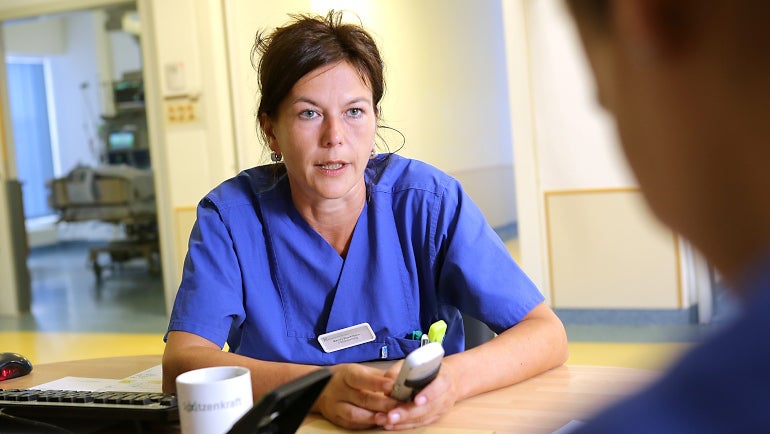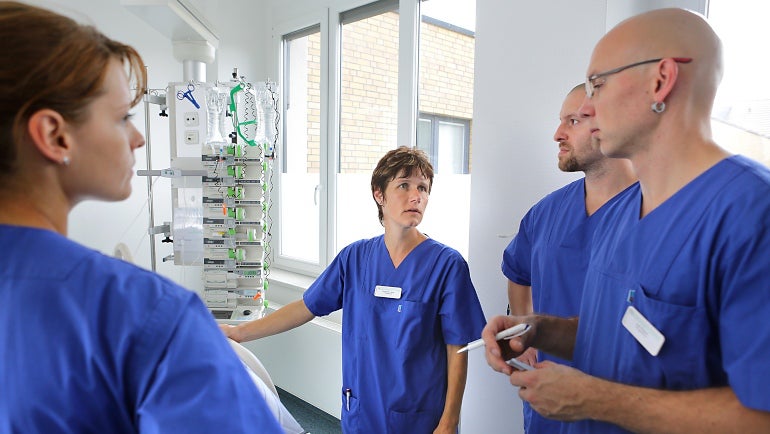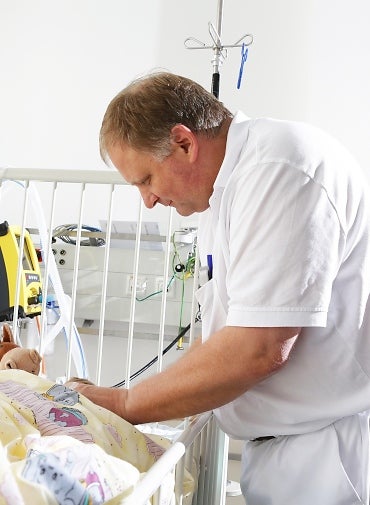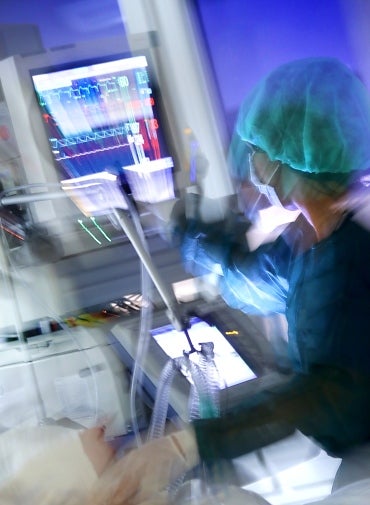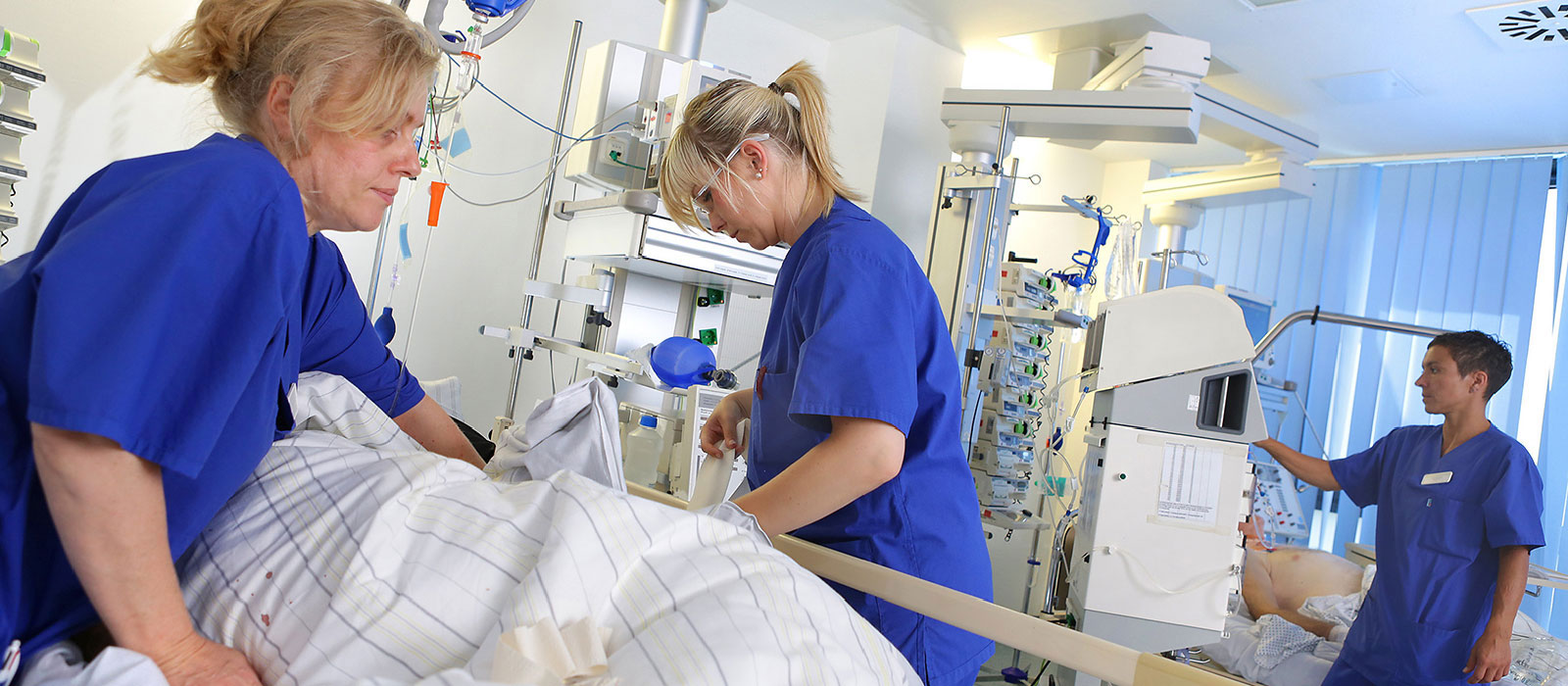
There’s not much conversation in the locker room at 6:30 a.m., as the six women change into the blue uniforms worn on the Intensive Care Unit. The handover from their overnight colleagues proceeds quietly — it was an uneventful night. But the day ahead? On the ICU, it’s impossible to know.
(Published: March 2015)
ICU head nurse Mandy Stockmann is busy handing out assignments. “When possible, we team up the less experienced people with the veterans,” she says. By any standard, Stockmann is a veteran: she has been heading the 67-member ICU nursing team at Fresenius Helios Hospital Bad Saarow, just east of Berlin, since she was 26.
Each member of the Bad Saarow ICU team is trained to deal with the life-threatening emergencies that can strike the ICU’s critically ill patients at any time. Many have just had major surgery or have advanced pneumonia. Others have suffered a serious heart attack or stroke, or devastating brain or internal injuries.
“We treat every patient like they were our own mother or father.”
Stockmann turns to hurry “downtown” — the English name the nurses have given the busy central corridor running between the ICU unit’s two wings, with their total of 36 beds. Downtown is where the doctors and nurses gather for their “morning rounds” to see the patients. The beeping of sophisticated medical equipment deployed throughout the ICU, along with the hoses, cables and flashing monitors — it can all seem daunting. For the ICU patients surrounded by — and often attached to — these life-saving machines, it is crucial that they sense the staff’s compassion, and special attention is given to treating them as gently and kindly as possible. “We treat every patient like they were our own mother or father,” says the head of the ICU, Dr. Uli-Ruediger Jahn.
“How was your night? Do you have any pain?” Jahn quietly asks a patient. During the morning visit he is highly focused, and expects the same from the staff. “This is the most important time of the day,” Jahn explains. “It’s the only time that the different specialist doctors all come together as a multi-disciplinary team. Everyone really has to listen closely.”
12:30 p.m.: Just after noon, the colleagues gather in Jahn’s office. Their faces etched in concentration, they examine the X-rays of patients as colleagues outside continue to closely monitor patients. The frequent checking of vital signs and medication levels, the carrying out of specially ordered tests such as lung endoscopies, as well as respiration therapy and the various measures needed to support patients’ circulatory systems: these are among the regular duties in the ICU workday.
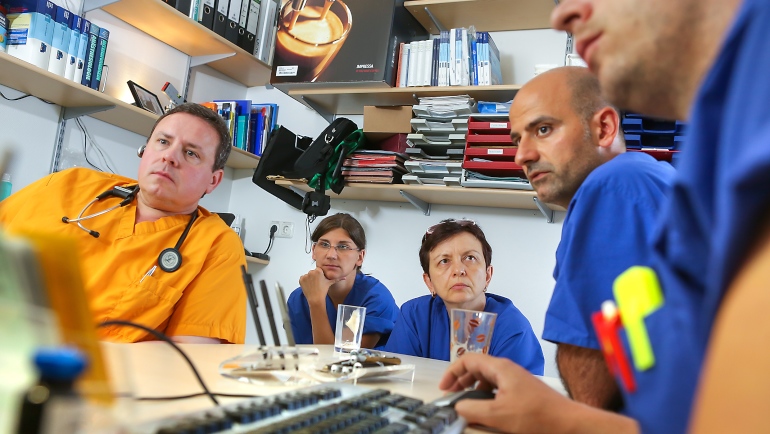
“Interdisciplinary cooperation takes on a different level of significance in the ICU,” and the nursing staff is on the front line of care, says Dr. Stefan Wirtz, the hospital’s Chief Physician for Anesthesiology, Intensive Care Medicine, Emergency Care Medicine and Pain Therapy. After all, he points out, it is the nurses who spend the most time with the patients, watch over them day and night, and notice even the smallest changes in their condition. “You can only do medicine well when you work in friendly cooperation with your colleagues,” Wirtz adds. “That’s true for doctors and for the nursing staff.
5 p.m.: Another long day ends for Mandy Stockmann at 5 p.m., and she turns to the important business of properly winding down. “Symbolically, it’s important to leave all your private worries in your locker when you start your shift, and then put work problems or your concerns about the patients aside, along with your uniform, at the end of your day,” Stockmann explains. “And I really long for peace and quiet, so I turn the phone off for an hour when I get home.”
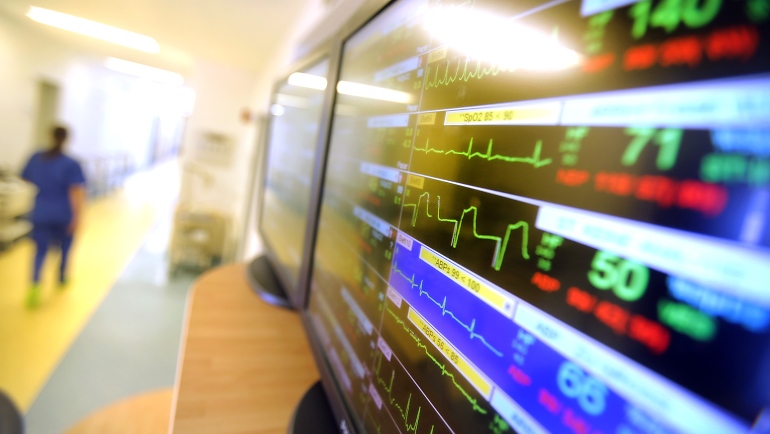
The night shift takes over at 10 p.m., with nurse Uwe Bogner as shift leader. This night soon sees him racing over to a nearby station to assist colleagues in helping a very heavy patient back into bed. Then word comes in that a planned emergency operation is being canceled because the patient is too weak, and all the equipment that the staff had brought out and set up for post-surgical care must now be put away. Other nurses, meanwhile, organize things for the day shift, while the physician on call attends to a patient who cannot come to rest; everyone knows that fear and anxiety do most of their visiting at night. The night shift is drawing to a close in the Bad Saarow ICU when Uwe Bogner approaches a patient to clear his throat of fluid that could obstruct breathing. The nurse knows the sedated patient will not be able to answer, but he takes a moment to speak to him all the same. “Good evening, Mr. K,” Bogner says softly. “Hope I didn’t startle you.”
6:30 a.m.: The unit is quiet. Three doors down, Uwe Bogner’s colleagues have arrived for the early shift and are quietly changing into their blue ICU uniforms.
Dr. Uli-Ruediger Jahn has assumed the position of Chief Physician for Anesthesiology, Intensive and Emergency Medicine and Pain Therapy at HELIOS Hospital Uelzen, in northern Germany. The Intensive Care Unit and the clinic for Anesthesiology and Pain Therapy have since become separate specialist departments within HELIOS Hospital Bad Saarow. Dr. Stefan Wirtz is Chief Physician, and Ali Allam is Senior Consultant, in the Intensive Care Unit.
Contact
Helios Kliniken GmbH
Friedrichstr. 136
10117 Berlin
Germany
T +49 30 521 321-0


